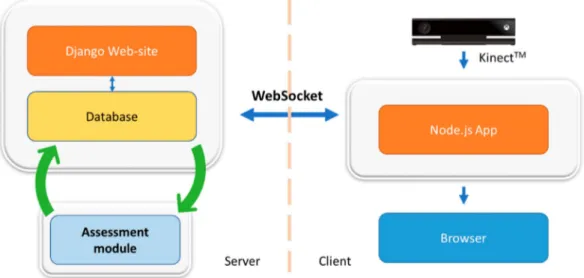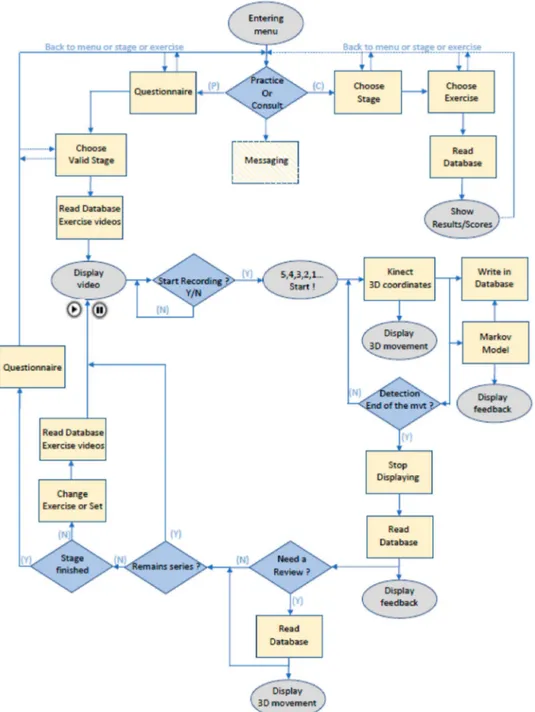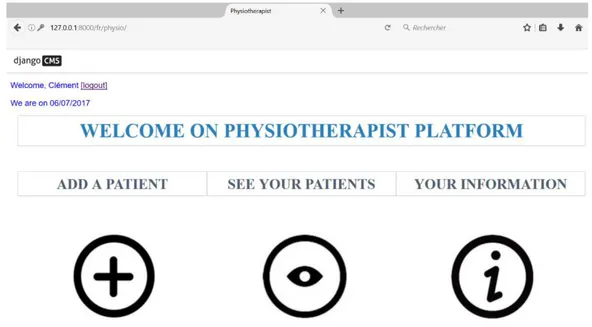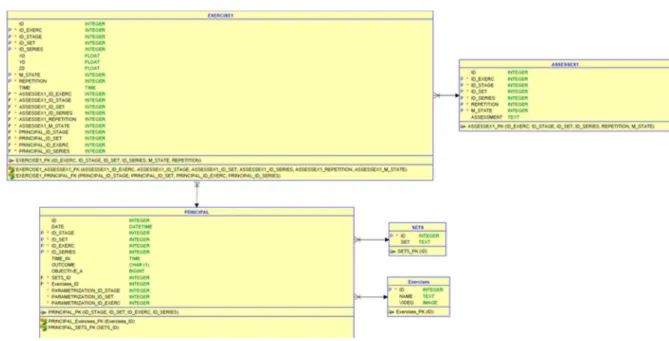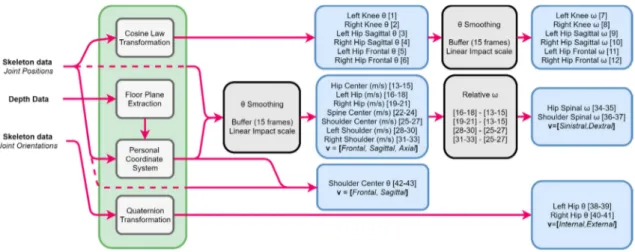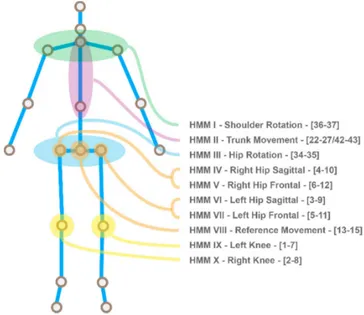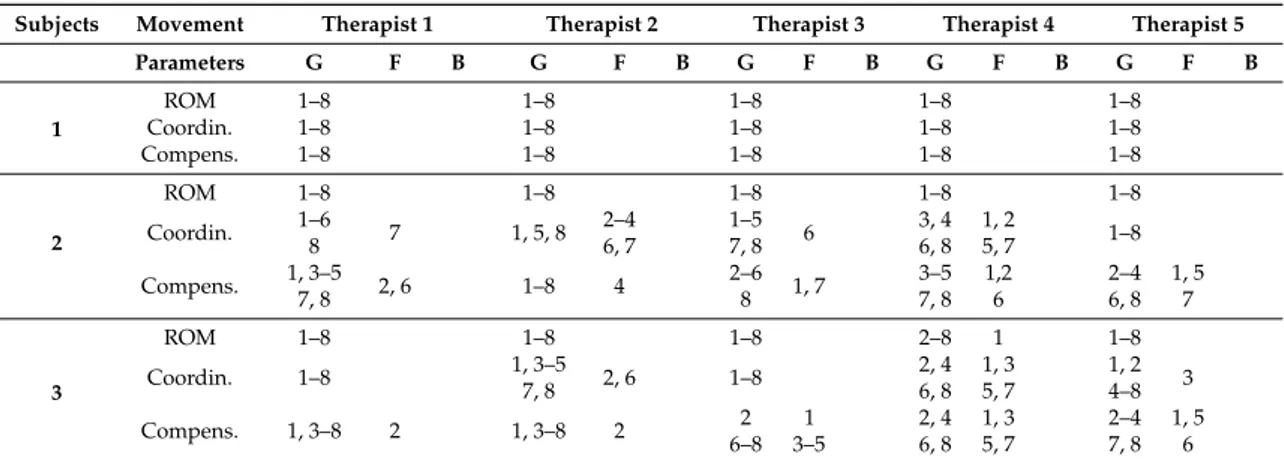sensors
Article
Smart Web-Based Platform to Support
Physical Rehabilitation
Yves Rybarczyk1,2,*ID, Jan Kleine Deters3, Clément Cointe4 ID and Danilo Esparza1
1 Intelligent & Interactive Lab (SI2Lab), Universidad de Las Américas, Quito 170124, Ecuador;
wilmer.esparza@udla.edu.ec
2 Department of Electrical Engineering, CTS/UNINOVA, Nova University of Lisbon,
2829-516 Monte de Caparica, Portugal
3 Faculty of Electrical Engineering, University of Twente, 217 7500 Enschede, The Netherlands;
j.kleinedeters@utwente.nl
4 Ecole Normale Supérieure de Paris-Saclay, 94235 Cachan, France; clement.cointe@ens-cachan.fr
* Correspondence: yr@uninova.pt; Tel.: +351-2-1294-8545
Received: 29 March 2018; Accepted: 23 April 2018; Published: 26 April 2018
Abstract: The enhancement of ubiquitous and pervasive computing brings new perspectives in medical rehabilitation. In that sense, the present study proposes a smart, web-based platform to promote the reeducation of patients after hip replacement surgery. This project focuses on two fundamental aspects in the development of a suitable tele-rehabilitation application, which are: (i) being based on an affordable technology, and (ii) providing the patients with a real-time assessment of the correctness of their movements. A probabilistic approach based on the development and training of ten Hidden Markov Models (HMMs) is used to discriminate in real time the main faults in the execution of the therapeutic exercises. Two experiments are designed to evaluate the precision of the algorithm for classifying movements performed in the laboratory and clinical settings, respectively. A comparative analysis of the data shows that the models are as reliable as the physiotherapists to discriminate and identify the motion errors. The results are discussed in terms of the required setup for a successful application in the field and further implementations to improve the accuracy and usability of the system.
Keywords: telemedicine; motor rehabilitation; motion assessment; natural user interface; Hidden Markov Model
1. Introduction
A current trend in rehabilitation medicine is the concept of a remote therapy system [1,2]. This concept consists of enabling patients to carry out part of the rehabilitation at home and to communicate through the Internet the evolution of the recovery process. The implementation of such a technology is justified by medical (improvement of the recovery process by the possibility to perform rehabilitation exercises more frequently), economic (reduction of the number of medical appointments and the time patients spend at the hospital), mobility (diminution of the transportation to and from the hospital) and ethics (healthcare democratization and increased empowerment of the patient) purposes [3,4]. Nevertheless, the fact that the patients can perform the rehabilitation exercises by themselves and without the supervision of a therapist raises an issue regarding the correctness of the therapeutic movement [5,6].
The present study exposes a web-based platform for physical tele-rehabilitation for patients after hip arthroplasty surgery. This orthopedic procedure is an excellent case study, because it involves people that are limited in their mobility and who need a postoperative functional rehabilitation
program to recover strength and joint mobility. The proposed approach considers two fundamental conditions for the development of a suitable tele-rehabilitation platform [7,8]. First, the system makes use of a low-cost motion capture device, in order to be economically viable. Second, the platform integrates an artificial intelligent module that automatically assesses the correctness of the executed movement to provide the patient with real-time feedback.
The remainder of the manuscript is organized into six parts. Section2presents related work in tele-rehabilitation systems. Section3is a general description of the web-based platform (frontend and backend). Section4focuses on the used method to develop the assessment module, which is based on Hidden Markov Models (HMMs). Section5consists of a laboratory experiment that tests the reliability of the HMMs to discriminate between correctly and incorrectly performed movements, and by comparison with the assessment made by therapists. Section6is a similar experiment carried out in clinical conditions and with patients after hip replacement surgery. Finally, the last section discusses (i) the results of the automatic assessment and possible improvements of the algorithm; (ii) the required setup for a reliable classification of the movements in real conditions; and (iii) a user-friendly application to enable the therapists to generate assessment models on any kind of new exercises.
2. Related Work
Sensors2018,18, 1344 3 of 21
Table 1.Characteristics of studies on tele-rehabilitation systems.
Studies Type Motion Capture Movement
Assessment Feedback
Biological
Features Application System Evaluation Contribution/Results
Fortino and Gravina, 2015 [9]
Theoretical and applied research
Wearable device—Inertial
sensors Not presented Visual—Avatar limb
Optimized for upper limbs
General motor
rehabilitation Not presented Scalable system Pedraza-Hueso
et al., 2015 [12] Applied research Vision-based—Kinect No
Visual—Avatar of a serious game
Movements of the whole body
Workout for
elderly Not presented
Attractive virtual environment Da Gama et al.,
2012 [13] Applied research Vision-based—Kinect 2D range of motion Textual Upper limbs
General motor rehabilitation
Physiotherapists and elderly
Avoiding wrong movements by guidance
Brokaw et al., 2013 [14]
Experimental
research Kinect and robotic system
By comparison with a
reference Haptic Upper limbs
Stroke
rehabilitation One health subject Multimodal interaction
Antón et al.,
2015 [15] Applied research Vision-based—Kinect Dynamic Time Warping No
Posture and movements General motor rehabilitation Compared with therapists’ assessment
Accurate discrimination of the movements
Gal et al., 2015 [16] Applied research Vision based—Kinect Dynamic Time Warpingand Fuzzy Logic Textual Posture andmotion ranges
Diagnostic of physical impairments
Not on real patients Tested on healthy subjects
López-Jaquero et al.,
2016 [17] Theoretical research
Natural User
Interface—Kinect Not presented Not presented Body joints
Upper limbs
rehabilitation Not presented
3. Web Platform
3.1. Global Architecture
One of the main goals of the web application is to be easy to use for patients and physiotherapists. The rehabilitation platform is supported by a client-server architecture (Figure1). The server contains the remote application and the associated database. The user’s interface enables patients and therapists to manage the display and the use of the Kinect data. The client-server connection is established via Web Socket as communication protocol.
Figure 1.Platform architecture.
3.1.1. Django Website Server
The website is based on Django, a web framework written in Python. For an effective development, it was decided to use Django CMS, a content management system that simplifies the implementation of the web application.
3.1.2. Client Side
Sensors2018,18, 1344 5 of 21
Figure 2.Patient’s interface during the practice of a rehabilitation exercise.
3.1.3. Web Socket
Node.js includes a library named Socket.IO and allows the deployment of a real-time bidirectional event-based communication. To do so, the destination address of the data (the address of the server hosting the website) must be declared in the Node.js application, and the IP address of the sender must be declared in the Django website. Through this method, the library Socket.IO for Python and the one for Node.js are able to communicate by using a function call.
3.2. Users Interface
The website can accommodate different types of users, such as patients and therapists. The functionalities are singular for these two kinds of users. The rehabilitation is divided into several parts, called stages. Each stage corresponds to a different level in terms of the intensity of: (i) Range of Movement (ROM); (ii) Stretching; (iii) Force; and (iv) Walking. The transition from one stage to another is allowed when the patient completes correctly all the exercises of the current stage and receives the physiotherapist’s consent. In other words, the physiotherapist only can unlock a stage according to the progress of the patient.
3.2.1. Patient Interface
Figure3shows the workflow of the patient interface. The patients have the choice to practice exercises, consult their performances, or send a message to the health professionals.
assessment associated are saved into the database. At the end of the exercise, the patients can review their movements and have a detailed feedback on their performance. The same questionnaire as previously mentioned is asked to the user at the end of a practical session, in order to provide the therapist with information on the state of the patient after performing the physical exercises.
Consult.This section allows the patients to check the results and performances of the exercises they achieved.
Messaging. This section allows the patient to exchange messages with a health professional (questions, advice, etc.).
Sensors2018,18, 1344 7 of 21
3.2.2. Physiotherapist Interface
Several functionalities are available for the health professionals. First, they have to create an account if they are not yet registered. After that, as shown in Figure4, it is possible to: (i) add a new patient and/or update information on existing patients; (ii) monitor the performance, progress and movements of the patients; and (iii) send and/or receive messages from patients. Physiotherapists have also the possibility to update the intensity of the rehabilitation program.
Figure 4.Physiotherapist interface (main menu).
3.3. Database Modelling
The database is directly associated with the Django website. Django CMS integrates a relational database management system named SQLite3, which is adequate for the requirements of the tele-rehabilitation platform.
3.3.1. User Database
This database stores different information about the users, such as: name, e-mail, age, occupation, city, etc.
3.3.2. Exercise Database
The modelling of this database is as follows (see, Figure5):
Main table.This table synthetizes the data about the exercises completed by the patient (date, kind of exercise, stage, completion time, etc.) and the corresponding outcome performance. During the execution of an exercise, fractions of the entire movement are assessed in real-time, in order to evaluate the correctness of the performed movement. Then, a single outcome (good, fair or bad) is produced based on the sum of these individual assessments (see, next section for more details on the assessment module).
Exercises table.This table, linked to the Main table through a 1:N relationship, provides details about each exercise and a demonstration video of the movement that must be performed.
Assessment table.This table is linked to each Data Exercise N◦* table, through a 1:N relationship, and stores the evaluation calculated by the assessment module for each part of the movement (see Figure3, Markov Model box).
Sets table.This table, linked to the Main table by a 1:N relationship, describes the nature of the exercise (balance, coordination, ROM and force).
Figure 5.Architecture of the database.
3.3.3. Questionnaire Database
This database stores all the questionnaires answered by the patients and provides the physiotherapist with a medical history and a permanent monitoring of the patient’s condition.
4. Assessment Module
4.1. Hidden Markov Approach
To evaluate in real time the quality of the movement performed by the patient, an artificial intelligent program is developed to be integrated into the physical tele-rehabilitation platform as an assessment module. Our approach is based on the Hidden Markov Model, which is a probabilistic model that can be applied for time series analyses, such as gestures.
Sensors2018,18, 1344 9 of 21
This is an iterative process, in which the objective is to find an optimal solution (state sequence) for the HMM. This optimal sequence of states is inferred using the Viterbi algorithm. Also, the forward algorithm can be used to calculate the probability that a sequence is generated by a specifically trained HMM, making it applicable for classification.
HMMs are characterized by a set of real world observations (o1, . . . ,on) where (o1, . . . ,on)ǫ
X(Discrete,
(ℎ ) ( |ℎ ) (ℎ |ℎ ) ( |ℎ )
(ℎ ) ( ) ( , )
− ϵ ℤ
ε ϵ ℤ
ϵX(Discrete, ℝ
ε
ϵ ℝ
π ϵ
( )
, e.g.,). ‘States’ can be inferred from these observations. This set of ‘hidden states’ (h1, . . .
,hn) takes values as follows: (h1, . . . ,hn)ǫY(
ϵ
ℝ
ϵ Yℤ). The sequence of this set is represented in Figure6. Since each state depends on its previous state and the observations are conditionally independent given the state, the joint probabilityp(o1, . . . ,on,h1, . . . ,hn) is obtained by the factorization shown in (1).
p(h1)p(o1|h1) n
∏
i=2
p(hi|hi−1)p(oi|hi) (1)
Figure 6.Trellis diagram of a Hidden Markov Approach (HMM).
The transition probabilities include all the probabilities of changing from one hidden state (i) to another (j), such asT(j,k)= p(hi = k | hi−1= j) where j,kǫ Y(
ϵ
ℝ
ϵ Yℤ(1,..., n)) and result into a n×n sized matrix (transition matrix). The emission probabilities are described byεl(o) = p(o | hi= l)where
lǫY(
ϵ
ℝ
ϵ Yℤ(1, ..., n)) and correspond to the states.oǫX(Discrete,
(ℎ ) ( |ℎ ) (ℎ |ℎ ) ( |ℎ )
(ℎ ) ( ) ( , )
− ϵ ℤ
ε ϵ ℤ
ϵX(Discrete, ℝ
ε
ϵ ℝ
π ϵ
( )
, e.g.,) and corresponds to the observed data. Eachεl(o)is a probability distribution function (PDF) of the observed data forstate l.There are different distribution types depending on the values ofX. A distribution type for these probabilities must be defined within the algorithm. For Discrete values, the distribution type could be a Probability Mass Function (PMF) or multinomial distribution, whereas foroǫX(
(ℎ ) ( |ℎ ) (ℎ |ℎ ) ( |ℎ )
(ℎ ) ( ) ( , )
− ϵ ℤ
ε ϵ ℤ
ϵX(Discrete, ℝ
ε
ϵ ℝ
π ϵ
( )
)commonly used distribution types are Gaussian based (regular Gaussian emissions and Gaussian mixture emissions). Finally, the initial distribution isπ(l) = p(hl= l)wherelǫY(z(1,..., n)) (being a PMF) and is described in (2).
π(h1)εh
1(o1) n
∏
i=2
T(hi−1,hi)εhi(oi) (2)
Using the forward algorithm, it is possible to calculate the probability that a sequence is generated by a trained HMM. Calculating the probably for a sequence on N trained HMMs and choosing the highest probability provides us with a recognition and further assessment of the movement.
4.2. Feature Representation
in the frontal, sagittal and horizontal planes. The proposed total feature representation is represented in Figure7.
Figure 7.Proposed feature representation. The green box represents the required processing steps. The grey boxes indicate minor transformations. And the blue boxes are the sets of features. The arrows show the direction of the data flow.
The transformation from joint positions to angles is one of the straight forward tasks and can be computed rapidly utilizing the cosine law (3). The absolute lengths between joints are calculated, in order to extract an angle as feature. The first features are created to represent the relative pose of the subject. These are features 1–6 as shown in Figure7.
Cos(A) = −a
2+b2+c2
2bc (3)
Then, additional vectors are computed in a similar fashion, in order to represent hip rotations in the sagittal plane (Figure8). With the floor plane orientation, the Personal Coordinate System (PCS) can be constructed. The additional data required in this step are the left and right hip joint position data. The vector that crosses both these points can be translated onto the reference point. Now at this point two vectors meet at the reference point and enable the third direction to be extracted by finding the perpendicular of these directions. This can be done by using the cross-product rule (4).
A→× B→= [a2b3−a3b2, a3b1−a1b3, a1b2−a2b1] (4)
Using the newly found orientations, the absolute coordinates per joint can be translated into personal coordinates, where the origin is the floor crossing with the earlier mentioned scalar (Figure8). Note that the PCS is rotation invariant so that movements can be expressed in terms of front/back, left/right and up/down. The speeds in the three directions are differences in orientation between consecutive frames. Here, the speed is calculated as an averaged sum of 15 frames (±0.25 s). The rotational values (features 34–37) are also calculated using the absolute values.
Sensors2018,18, 1344 11 of 21
Figure 8.Vectors creating the personal coordinate system with the center floor point being the new origin. The cyan lines represent the lower limbs. The dotted lines indicate the additional vectors that are required to calculate hip movements in the sagittal plane.
4.3. Trained HMMs
The features are input into the learning parameters on the level that semantics comply with a therapist’s analysis of an exercise. Most coarse types of movements (with this semantic similarity) are incorporated into the HMM representation, where the restrictions of the Skeletonization algorithm are also taken into account (e.g., no trunk bending possible). This means that the earlier developed multi HMM assessment has advanced into a 10-fold semantic manifestation, which is represented in Figure9. For each of these HMMs, two measures advance into the assessment blueprint. The forward probabilities are used with a sliding window to indicate the likelihood of each phenomenon within the movement. This pinpoints the location of an error, if this occurs in one of the HMM elements. Then, the state transition sequence is passed on to be analyzed on symmetrical values and coordination between the different HMM elements. When the forward pass provides a low likelihood, the corresponding state mean values (those containing directional speed) are compared in an absolute fashion to determine the direction of the error.
5. Experiment 1
An automatic assessment of the quality of the performed exercises is implemented according to a Hidden Markov Models (HMM) approach [25]. This technique provides insights into the ontological structure of the rehabilitation exercises and represents a probabilistic interpretation of the correctness of movement execution [22,26]. Here, the ontology of different compensatory movements associated with an exercise of hip abduction of the right leg are evaluated from an experiment on healthy participants. Compensation strategies are commonly used by patients to make exercises easier [27]. However, these compensatory movements limit functional improvements from therapy of the affected limb and can cause pain [28,29]. This is the reason why several motor rehabilitation support systems were interested in identifying and limiting these compensations, in order to recover a normal joint coordination for an appropriate use of the limb in everyday life activities [13,14]. The accuracy of the proposed algorithm is validated by a comparison with the assessment made simultaneously by physiotherapists, as it is suggested by other studies to evaluate e-rehabilitation systems [13,15].
5.1. Setup and Protocol
Nine subjects took part in the study. The experiment consisted of executing a rehabilitation exercise of hip abduction. This exercise was repeated eight times per participant. Simultaneously, five therapists rated the movement on three different aspects. These aspects were range of motion (ROM), coordination, and compensation. ROM corresponds to the amplitude of the movement. Coordination is related with the synchronicity of different body parts during the execution of an exercise. Compensations were defined as undesired movements, which were not expected to be performed. Subjects received feedback regarding the correctness of their performance after the fifth repetition. Then, each of the three-remaining repetitions was followed by systematic feedback from the therapists.
The representation of the Kinect’s skeletal data is based on the degrees of freedom per joints. The created feature vector contains four variables (Table2). Two of these features are the absolute value of the linear speeds of the hip center joint and the shoulder center joint (features F0–F1, in Table2). The speeds are calculated using a buffer of 15 frames (around 0.25 s) as a denoising method. The speed is the average of the values contained in the buffer. This buffer gets updated at every frame by discarding the oldest data point and adding the newest one. In this sense the data stream becomes available after the buffer is filled. Also, the angles of the upper legs in frontal planes (feature F3, in Table2) are integrated into the model. The angles are calculated with the cosine law. At last, the speed paths of this last feature (feature F2, in Table2) are created in the same fashion as stated previously.
Table 2.Feature vector.
F0 F1 F2 F3
Hip center speed (m/s) Shoulder center speed (m/s) Right hip speed (Frontal planeθ/s) Right hip angle (Frontal planeθ)
5.2. Models Training
Sensors2018,18, 1344 13 of 21
were trained. Each model can predict the state of a specific joint or joint group (as the trunk in the skeleton representation is rigid). This is useful as a fault can occur in one of these groups only, while the rest can be correctly executed. In addition, every part of a movement can be correctly executed, but badly synchronized. Such structure enables us to identify if a movement in one joint initialized and stopped earlier or later, as state transitions are easy to obtain. The characteristic pattern of a movement expressed in states leads to the knowledge of which state is associated with the movement initialization and termination.
Table 3.Feature sets and amount of states.
HMM II HMM V
Features -- Shoulder center (m/s)Hip center (m/s) - Right hip frontal ( θ/s)
- Right hip frontal (θ)
Amount of States 3 4
Name Trunk Movement Right Hip Frontal
5.3. Results
Here, the performance of three subjects after the execution of a movement of hip abduction are presented. The result of the labelling shows a global consensus, but also some inconsistences between the therapists. Table4shows the labels for this sample of three participants. For each subject, the first row is the ROM rating, the second row is the coordination rating, and the third row is the compensation level.
Table 4.Labels (G for ‘good’, F for ‘fair’, and B for ‘bad’) for a sample of three subjects. The digits correspond to the Id number of the trial.
Subjects Movement Therapist 1 Therapist 2 Therapist 3 Therapist 4 Therapist 5
Parameters G F B G F B G F B G F B G F B
1
ROM 1–8 1–8 1–8 1–8 1–8
Coordin. 1–8 1–8 1–8 1–8 1–8
Compens. 1–8 1–8 1–8 1–8 1–8
2
ROM 1–8 1–8 1–8 1–8 1–8
Coordin. 1–6
8 7 1, 5, 8
2–4 6, 7
1–5 7, 8 6
3, 4 6, 8
1, 2
5, 7 1–8
Compens. 1, 3–57, 8 2, 6 1–8 4 2–68 1, 7 3–57, 8 1,26 2–46, 8 1, 57
3
ROM 1–8 1–8 1–8 2–8 1 1–8
Coordin. 1–8 1, 3–57, 8 2, 6 1–8 2, 46, 8 1, 35, 7 1, 24–8 3
Compens. 1, 3–8 2 1, 3–8 2 2 6–8 1 3–5 2, 4 6, 8 1, 3 5, 7 2–4 7, 8 1, 5 6
The compensation is estimated through the symmetry of the movement, because it provides us with an insight on the motor control over the execution, which must be characterized by an even distribution of the agonist and antagonist muscular load in case of symmetry. It is first calculated by extracting the signal of the shoulder center joint on both terminations: beginning and end of the rest state (0).
Table5shows these ratios. Values > 1 mean that returning to the initial pose took longer than reaching the maximum amplitude of the movement and inversely for ratios < 1.
(a) (b)
θ
Figure 10. Speed path of the shoulder center (dotted lines) and angular speed of the right hip (continuous lines), for two different trials of an exercise of hip abduction: trial 7 of subject 2 (a) and trial 2 of subject 1 (b). The linear speed of the shoulder center is 1500 times magnified in this representation. The x-axis represents the number of frames, where every frame has a period of time of 1/60 s. The y-axis represents the velocity in m/s for the shoulder movement andθ/s for the
hip movement.
Table 5.Synchronicity between shoulder movement and symmetry of shoulder movement. Values close to 1 resemble a perfect synchronicity or symmetry. For synchronicity, values < 1 mean that the shoulders moved before the hip abduction and values > 1 mean that the shoulder center moved after the hip abduction. For symmetry, scores < 1 mean the shoulder center reached the maximum amplitude faster than it returned to the beginning pose and the opposite for scores > 1. For values > 1 an inverse value (1/value) is given in parenthesis, in order to calculate the average value for synchronicity and symmetry.
Synchronicity Subject 1 Subject 2 Subject 3
Trial 1 0.93 0.79 0.95
Trial 2 1.06 (0.94) 1.16 (0.86) 0.74
Trial 3 0.86 0.91 1.21 (0.82)
Trial 4 0.73 0.61 0.64
Trial 5 1.54 (0.65) 0.74 0.73
Trial 6 0.93 0.93 0.71
Trial 7 0.74 0.72 2.14 (0.46)
Trial 8 1.01 (0.99) 0.84 0.87
AVERAGE 0.85 0.8 0.74
Symmetry Subject 1 Subject 2 Subject 3
Trial 1 1.09 (0.92) 0.79 0.95
Trial 2 1.29 (0.78) 1 0.94
Trial 3 0.82 0.93 1.4 (0.71)
Trial 4 0.85 0.6 0.87
Trial 5 1.54 (0.65) 0.78 0.82
Trial 6 1.01 (0.99) 0.83 0.76
Trial 7 0.78 0.68 3.4 (0.29)
Trial 8 1.16 (0.86) 0.76 1
AVERAGE 0.83 0.79 0.79
Sensors2018,18, 1344 15 of 21
in lengths of the shoulders clipping points on the left and the right side of this point. Figure10a,b show an example of an incorrect and correct coordination of the movements, respectively. Figure10a corresponds to the trial 7 of subject 2, which was classified by three therapists out of five as not perfectly coordinated (see Table4). It can be noted on this trial a minor shift of the speed paths of the shoulder center to the left with respect to the angular speed of the hip abduction (ratio = 0.72, which is lower than the average value of 0.8 for this individual). In contrast, Figure10b shows a trial that is almost perfectly synchronized (ratio = 0.94) as both valleys (movement of shoulder center and movement of abduction) are close to align.
6. Experiment 2
The second experiment is set up to study the applicability of the HMM models in assessing the quality of the self-rehabilitation movements in real-time and in clinical conditions. The quality is evaluated as correct or incorrect, with compensation faults that cover the most common errors during a regular rehabilitation program. Such an experiment is justified by the fact that unfortunately a large majority of the prototypes that aim to support physical rehabilitation are not tested on the end users [30].
6.1. Setup and Protocol
Two patients (74 and 77 years of age) and one healthy subject participated in this experiment. The patients were attending their regular session of physiotherapy for their rehabilitation. Both patients had undergone hip replacement surgery at their right hip. This surgery took place 1.5 and 3 weeks prior to the experiment (i.e., early stage recovery). All the participants were informed and gave their consent on the gathering of their exercise data and later use for scientific research purposes. Ethics clearance for this study was granted by the Nova University of Lisbon. Videos of the whole session were created as well as in depth images for further extraction of the skeleton and applying the input transformation into the desired feature representation. The participants were asked to perform five different exercises, which were repeated eight times (i.e., total of 120 recordings). The executed exercises were: hip abduction, hip extension, hip flexion in standing position, hip flexion in sitting position, and a three-step exercise (step forward followed by step to the side and later step backwards). Two therapists were asked to rate the quality of the movements performed by the subjects. Three aspects were evaluated: range of motion (ROM), compensation, and coordination. Table3
describes the characteristics of the trained HMMs that were used in this experiment (HMM II and HMM V) to classify the movements of a patient and compare the results to the healthy subject. Then, the therapists’ evaluations were used to determine if the compensatory movements were correctly identified by the HMMs.
6.2. Results
6.2.1. Conditioning
(a) (b)
Figure 11.The two patients executing a therapeutic exercise of hip abduction: (a) is patient 1; (b) is patient 2.
6.2.2. Classification Comparison
An analysis is performed on the executions of patient 2 regarding hip abduction. This is compared with the trials executed by the heathy subject. As shown in Table6, both therapists agree on the fact that executions 4 and 5 have a lesser quality (i.e., containing compensation to some extend).
Table 6.Therapist labelling of hip abduction for each trial (1–8).
Therapist 1 Therapist 2
Good Fair Bad Good Fair Bad
ROM 1–8 7, 8 1–6
Coordination 1–6, 8 7 1–8
Compensation 1–3, 6–8 5 4 1–3, 6–8 5 4
Figure12shows the classifications performed by the HMMs for both patient and healthy subject. The average probability of correct labelled exercises is 1261 for the patient vs. 1474 for the healthy subject, which indicates an average better execution by the healthy individual than the patient. The most relevant result of this analysis is the very low value (about 0) attributed by the HMM II to trial 4. It means that the model is able to identify that an error occurred in this trial. The fact that a similar assessment is made by the therapists (this trial received the lowest score) suggests that the automatic evaluation is as accurate as the human one.
Figure 12. HMM II (trunk model) classification for the 8 trials of patient 2 (blue) and healthy subject (orange).
6.2.3. Error Analyses
Sensors2018,18, 1344 17 of 21
with an insight on the motor control over the execution, which must be characterized by an even distribution of the agonist and antagonist muscular load in case of symmetry. This symmetry is defined by the difference in length (or number of frames) between the left and right side in relation to this minimum value. A ratio is obtained by dividing the time took to reach the maximum amplitude where speed≈0 (inversion of the direction of the movement represented by the green valley in Figure13, right panel) and the time took to return to the initial pose (end of the movement). Analyzing the video of trial 4 shows a clear compensation. This compensation was an uncontrolled deviation of the hip (center) moving to the left at the end of the movement. This is shown in Figure13, where the yellow line represents the speed of the hip center during this trial (left panel), and for a correct execution (right panel) by the patient. This compensation can be referred to as adduction and occurred on the left hip. It suggests that the joint did not present the stability required to correctly perform the exercise, because the muscles of the opposite hip could not support the body while returning to the initial posture.
≈
(a) (b)
Figure 13.Trunk (green dotted lines) and hip (yellow unbroken lines) movements of patient 2 during a hip abduction exercise. (a) A wrong execution (trial 4), in which a compensation occurred at the end of the movement. (b) The example of a movement identified as correct (trial 3).
Trial 5 was classified as fair, only. Figure14 (left panel) represents the velocity of the trunk movement for a correct (healthy subject) vs. an incorrect (trial 5 of patient 2) execution. An additional spike can be seen in the patient’s signal. The video shows that while approaching the maximal range within the execution the patient lost balance resulting in a minor fall. However, she was able to correct this in time and successfully terminated the exercise. This imbalance can be clearly seen when predicting the state transitions path (Figure14, right panel). A correct execution should have two ‘bumps’, only. However, the HMM detects an extra ‘bump’ in the mid-section, which corresponds to an additional state transition into state 2 (broken line). This result demonstrates that the state transition predictions are good indicators of compensation.
≈
(a) (b)
7. Discussion
This study demonstrates that HMMs permit a discrimination between accurately and wrongly executed movements of self-rehabilitation. The assessment module seems to capture to some extent the levels of synchronicity and compensation perceived by the therapists. In such an approach, the state transition sequences provide an important clue about the occurrence of compensations. Thus, it is imperative that the trained models learn the distribution of the states over time so that missing/added or elongated/shortened states are directly used as predictor of the correctness of the movement. Figure15shows an example of the probabilistic-based method applied in the HMM approach to detect a possible sequence mismatching. This technique of evaluation can also provide a qualitative insight regarding the stability and flexibility of the human body across the recovery process.
However, the algorithm could be substantially improved by including the total displacement of the trunk during the movement and a symmetric value for the distribution of the displacement, in which the total displacement would aid in detecting the allowed movements (not considered as compensation) and symmetry in displacement would provide an insight regarding the smoothness of the movements. In addition, the precision of the synchronicity could be increased by applying a curve fitting to the middle section of the speed paths (for shoulder and hip) and calculating the shift between the minimum of each curve. Also, more information on the compensatory movements could be obtained by determining the movement of the subjects regarding both the sagittal and the frontal planes. The evaluation of the force recovery was not developed in this study, since it is difficult to assess it using the Kinect. A possible option to overcome this limitation would be to implement a multimodal system using both a Kinect and a haptic device that could simulate the pressure the therapist applies to the limbs during a regular session [14].
Figure 15.Versioned detection of being in an unlikely state (red line). The transition path of an incorrect execution (trial 5 by patient 2) is used as an example to illustrate the distribution over time of the expected current state. Here, an undesired state is clearly identified in the middle of the sequence.
From a computational point of view, the algorithm could be adapted to Hidden Semi-Markov Models (HSMMs), in which the sequences are modelled in terms of duration distributions [31]. This approach allows for a higher flexibility of the transition probability than in the HMMs, which should increase the classification accuracy [32]. It is also to mention the fact that the HMM predictions can sporadically contain noise. This issue was partially caused by the patient’s clothing that reduced the accurate detection of the skeleton. Thus, the use of tight clothes must be preferred and advised while patients perform exercises. The mentioned learned state duration distributions could be applied as a signal pre-processing to identify possible misclassifications caused by a noisy input, or to discard the exercise from evaluation.
Sensors2018,18, 1344 19 of 21
any possible clinical setting or even field of motion analysis (e.g., sport, dancing, performance . . . ). To do so, the only requirement is to collect new measures regarding the kinematic of the joint-based features involved in the specific exercises of each therapeutic program. Then, these data will be used to train pertinent HMMs that will enable the system to identify possible faults in the execution of the movement, such as reduced ROM, compensation strategies, problems of coordination . . . or any other incompliance that will disturb the recovery process. These errors could be handled by a pipeline of assessment, in which the most serious errors will be tackled primarily in the form of a targeted feedback for the patient.
In order to facilitate this process, current work is focused on the development of an application to enable the therapists to easily create new assessment models that could be applied on any kind of rehabilitation exercises (see prototype interface in Figure16). CSV files can be loaded by clicking an HMM button. Before doing so, the features that are going to be used in training need to be assigned by typing them in the features section. To analyze the optimal amount of states that a dataset requires, Bayesian Information Criteria (BIC) can be performed. This creates a score using cross validation for states 2–10 (as a HMM exists at least out of 2 states). The amount of states to be used during the training can be declared in the states section. When all the parameters are set, the training button appears and the training can take place. When this step is done, the models can be saved.
Figure 16.User graphic interface of the HMM trainer.
Author Contributions:Y.R. provided the idea, designed the experiments and wrote the paper; J.K.D. developed the algorithms and analyzed the data; C.C. developed the web application; and D.E. performed the experiments.
Funding:This research was funded by CEDIA (Corporación Ecuatoriana para el Desarrollo de la Investigación
y la Academia), grant number CEPRA XI-2017-15.
Conflicts of Interest:The authors declare no conflict of interest. The founding sponsors had no role in the design of the study; in the collection, analyses, or interpretation of data; in the writing of the manuscript, and in the decision to publish the results.
References
1. Rybarczyk, Y.; Gonçalves, M.J. WebLisling: Uma plataforma terapêutica baseada na web para a reabilitação de doentes afásicos.IEEE Lat. Am. Trans.2016,14, 3921–3927.
2. Rybarczyk, Y.; Deters, J.K.; Gonzalvo, A.A.; Gonzalez, M.; Villarreal, S.; Esparza, D. ePHoRt project: A web-based platform for home motor rehabilitation. InRecent Advances in Information Systems and Technologies: Advances in Intelligent Systems and Computing; Rocha,Á., Correia, A.M., Adeli, H., Reis, L.P.,
3. Peretti, A.; Amenta, F.; Tayebati, S.K.; Nittari, G.; Mahdi, S.S. Telerehabilitation: Review of the state-of-the-art and areas of application.JMIR Rehabil. Assist. Technol.2017,4, 1–9. [CrossRef] [PubMed]
4. Rybarczyk, Y.; Vernay, D. Educative therapeutic tool to promote the empowerment of disabled people. IEEE Lat. Am. Trans.2016,14, 3410–3417. [CrossRef]
5. Jost, H. Kinect-based approach to upper limb rehabilitation. In Modern Stroke Rehabilitation through e-Health-Based Entertainment; Vogiatzaki, E., Krukowski, A., Eds.; Springer: Heidelberg, Germany, 2016; pp. 169–193.
6. Deters, J.K.; Gonzalo, A.A.; Esparza, D.; Gonzalez, M.; Villarreal, S.; Nunes, I.L. Recognition of physiotherapeutic exercises through DTW and low-cost vision-based motion capture. InRecent Advances in Information Systems and Technologies: Advances in Intelligent Systems and Computing; Nunes, I., Ed.; Springer: Heidelberg, Germany, 2017; Volume 592, pp. 348–360.
7. Scheideman-Miller, C.; Clark, P.G.; Moorad, A.; Post, M.L.; Hodge, B.G.; Smeltze, S. Efficacy and sustainability of a telerehabilitation program. In Proceedings of the 36th International Conference on System Sciences, Big Island, HI, USA, 6–9 January 2003.
8. Rybarczyk, Y.; Kleine Deters, J.; Cointe, C.; Aladro Gonzalo, A.; Esparza, D. Telerehabilitation platform for hip surgery recovery. In Proceedings of the 2nd IEEE Ecuador Technical Chapter Meeting, Salinas, Ecuador, 1 October 2017.
9. Fortino, G.; Gravina, R. A Cloud-Assisted Wearable System for Physical Rehabilitation. InCommunications in Computer and Information Science; Barbosa, S.D.J., Chen, P., Filipe, J., Kotenko, I., Sivalingam, K.M., Washio, T., Yuan, J., Zhou, L., Eds.; Springer: Heidelberg, Germany, 2015; Volume 515, pp. 168–182.
10. Fortino, G.; Parisi, D.; Pirrone, V.; Fatta, G.D. BodyCloud: A SaaS approach for community body sensor networks.Future Gener. Comput. Syst.2014,35, 62–79. [CrossRef]
11. Bonnechère, B.; Jansen, B.; Salvia, P.; Bouzahouene, H.; Omelina, L.; Moiseev, F.; Sholukha, V.; Cornelis, J.;
Rooze, M.; Van Sint Jan, S. Validity and reliability of the Kinect within functional assessment activities: Comparison with standard stereophotogrammetry.Gait Posture2014,39, 593–598. [CrossRef] [PubMed] 12. Pedraza-Hueso, M.; Martín-Calzón, S.; Díaz-Pernas, F.J.; Martínez-Zarzuela, M. Rehabilitation using
Kinect-based games and virtual reality.Procedia Comput. Sci.2015,75, 161–168. [CrossRef]
13. Da Gama, A.; Chaves, T.; Figueiredo, L.; Teichrieb, V. Guidance and movement correction based on therapeutic movements for motor rehabilitation support systems. In Proceedings of the 14th Symposium on Virtual and Augmented Reality, Rio de Janeiro, Brazil, 28–31 May 2012.
14. Brokaw, E.B.; Lum, P.S.; Cooper, R.A.; Brewer, B.R. Using the Kinect to limit abnormal kinematics and compensation strategies during therapy with end effector robots. In Proceedings of the 2013 IEEE International Conference on Rehabilitation Robotics, Seattle, WA, USA, 24–26 June 2013.
15. Antón, D.; Goñi, A.; Illarramendi, A. Exercise recognition for Kinect-based telerehabilitation.Methods Inf. Med. 2015,54, 145–155.
16. Gal, N.; Andrei, D.; Nemes, D.I.; Nadasan, E.; Stoicu-Tivadar, V. A Kinect based intelligent e-rehabilitation system in physical therapy.Stud. Health Technol. Inf.2015,210, 489–493.
17. López-Jaquero, V.; Rodríguez, A.C.; Teruel, M.A.; Montero, F.; Navarro, E.; Gonzalez, P. A bio-inspired model-based approach for context-aware post-WIMP tele-rehabilitation.Sensors2016,16, 1689. [CrossRef] [PubMed]
18. Kleine Deters, J.; Rybarczyk, Y. Hidden Markov Model approach for the assessment of tele-rehabilitation exercises.Int. J. Artif. Intell.2018,16, 1–19.
19. Melnikoff, S.J.; Quigley, S.F.; Russell, M.J. Implementing a Hidden Markov Model speech recognition system in programmable logic. InLecture Notes in Computer Science; Brebner, G., Woods, R., Eds.; Springer: Heidelberg, Germany, 2001; Volume 2147, pp. 81–90.
20. Khadr, M. Forecasting of meteorological drought using Hidden Markov Model (case study: The upper Blue Nile river basin, Ethiopia).Ain Shams Eng. J.2016,7, 47–56. [CrossRef]
21. Hassan, M.R.; Nath, B. Stock market forecasting using Hidden Markov Model: A new approach. In Proceedings of the 5th International Conference on Intelligent Systems Design and Applications, Warsaw, Poland, 8–10 September 2005.
Sensors2018,18, 1344 21 of 21
23. Fiosina, J.; Fiosins, M. Resampling based modelling of individual routing preferences in a distributed traffic network.Int. J. Artif. Intell.2014,12, 79–103.
24. Code Project (Kinect Joint Rotation—The Definitive Guide). Available online:https://www.codeproject. com/Articles/1189463/Kinect-Joint-Rotation-The-Definitive-Guide(accessed on 28 May 2017).
25. Papadopoulos, G.T.; Axenopoulos, A.; Daras, P. Real-time skeleton-tracking-based human action recognition using Kinect data. InLecture Notes in Computer Science; Gurrin, C., Ed.; Springer: Heidelberg, Germany, 2014; Volume 8325, pp. 473–483.
26. Mahapatra, A.; Tusar, K.M.; Pankaj, K.S.; Banshidhar, M. Human recognition system for outdoor videos using Hidden Markov Model.Int. J. Electron. Commun.2014,68, 227–236. [CrossRef]
27. Rainville, J.B.S.J.; Hartigan, C.; Wright, A. The Effect of compensation involvement on the reporting of pain and disability by patients referred for rehabilitation of chronic low back pain. Spine1997,22, 2016–2024. [CrossRef] [PubMed]
28. Krakauer, J.W. Motor learning: Its relevance to stroke recovery and neurorehabilitation.Curr. Opin. Neurol. 2006,19, 84–90. [CrossRef] [PubMed]
29. Ellis, M.D.; Holubar, B.G.; Acosta, A.M.; Beer, R.F.; Dewald, J.P. Modifiability of abnormal isometric elbow and shoulder joint torque coupling after stroke.Muscle Nerve2005,32, 84–90. [CrossRef] [PubMed] 30. Da Gama, A.; Fallavollita, P.; Teichrieb, V.; Navab, N. Motor rehabilitation using Kinect: A systematic review.
Games Health J.2015,4, 123–135. [CrossRef] [PubMed]
31. Mitra, B.; Meratnia, N.; Havinga, P.J.M.; Skidmore, A.K.; Toxopeus, B.A.K.G. A hierarchical Hidden Semi-Markov Model for modeling mobility data. In Proceedings of the 2014 ACM International Joint Conference on Pervasive and Ubiquitous Computing, Seattle, WA, USA, 13–17 September 2014.
32. Wang, Q.; Yuanrong, X.; Yen-Lun, C.; Yong, W.; Xinyu, W. Dynamic hand gesture early recognition based on Hidden Semi-Markov Models. In Proceedings of the 2014 IEEE International Conference on Robotics and Biomimetics, Bali, Indonesia, 5–10 December 2014.

